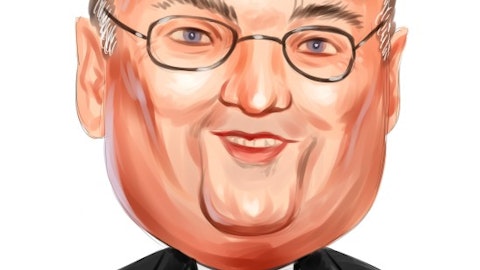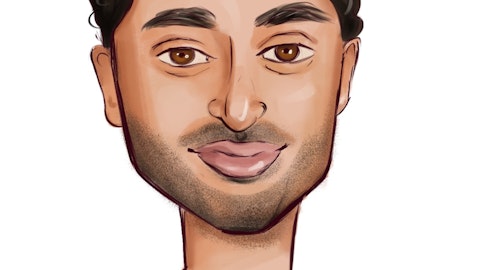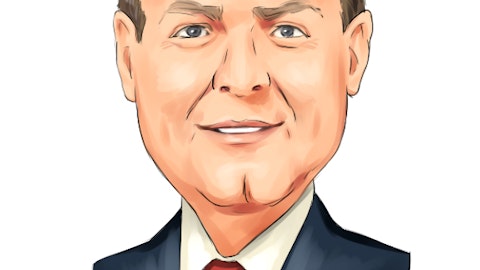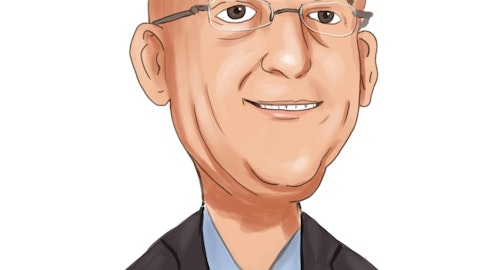ResMed Inc. (NYSE:RMD) Q2 2023 Earnings Call Transcript January 26, 2023
ResMed Inc. beats earnings expectations. Reported EPS is $1.66, expectations were $1.62.
Operator: Hello and welcome to the ResMed Second Quarter Fiscal Year 2023 Earnings Call. At this time, all participants are in a listen-only mode. As a reminder, this conference is being recorded. It’s now my pleasure to turn the call over to Amy Wakeham, Vice President, Investor Relations and Corporate Communications. Amy, please go ahead.
Amy Wakeham: Great. Thank you, Kevin. Hi, everyone. Happy new year and welcome to ResMed’s second quarter fiscal year 2023 earnings call. Thanks for joining us. This call is being webcast live and the replay will be available on the Investor Relations section of our corporate website later today, along with a copy of their earnings press release and presentation, both of which are available now. Joining me on the call today are Chief Executive Officer and Chairman, Mick Farrell; and Chief Financial Officer, Brett Sandercock. Mick will provide a brief high-level overview of our financial results, review our progress towards our ResMed’s 2025 strategic goals, and discuss our progress as we continue to navigate the ongoing macro industry and supply chain challenges.
Brett will then review our financial results in more detail. And we’ll then move into the Q&A portion of our call. During the Q&A session, Mick and Brett will be joined by Rob Douglas, President and Chief Operating Officer; and David Pendarvis, Chief Administrative Officer and Global General Counsel. During today’s, we will discuss several non-GAAP measures. For a reconciliation of the non-GAAP measures, please review the supporting schedules in today’s earnings press release. And as a reminder, our discussion today will include some forward-looking statements, including, but not limited to, expectations about our future operating and financial performance. We do believe these statements are based on reasonable assumptions. However, our actual results may differ.
Please review our SEC filings for a complete discussion of the risk factors that could affect our actual results to differ materially from any forward-looking statements made today. I’d like to now turn the call over to Mick.
Mick Farrell: Thanks Amy and Kevin and thank you to all of our stakeholders for joining us today as we review results for the December quarter, our second quarter of fiscal year 2023. Our financial results reflect solid performance across our entire business, once again driven by strong sales growth in the Americas region as we were able to significantly increase both production and delivery of flow-generated devices. We’re seeing ongoing high demand for our sleep and respiratory care devices worldwide and we’re making steady progress, working with our suppliers to continue to increase our production to ultimately meet the needs of all customers and especially patients. Our mask sales growth was strong across the globe, reflecting a post-COVID pandemic awareness of the importance and need for respiratory hygiene and respiratory health.
Resupply programs in the US continue to drive solid, ongoing sustained market mask growth catalyzed somewhat by the end of calendar year deductible momentum in the US geography. Masks sales across Europe, Asia, and the rest of world also improved, driven by increased new patient setups as connected device supply increased. Our teams worked incredibly hard to achieve these extraordinary numbers in the face of an ongoing industry supply chain constrained market. We see the supply environment improving every week, every month, and every quarter, and our access to the specific electronic components we need has increased. We are confident in our ability to fulfill all customer demand before the end of calendar year 2023 and we expect to see steady ongoing incremental device revenue growth in the third and fourth quarters of our fiscal year 2023.
Customer acceptance of our reengineered AirSense 10 Card-to-Cloud device remains strong during the second quarter, particularly in the United States geography. As we increase the volume of fully connected AirSense 10 and fully connected AirSense 11 devices over the next few quarters, we will be able to phase out the AirSense 10 Card-to-Cloud device and refocus on our strategy which is based around the growth of 100% cloud connectable devices across the globe. Outside the US, we have not seen the same adoption rates of that AirSense 10 Card-to-Cloud Device. However, there have been pockets of success in some geographies and we see a strong growth path going forward as we ramp up our fully connected AirSense 10 and our fully connected AirSense 11 products and as we achieve regulatory clearance of the latter platform market-by-market.
To that point, we introduced our newest product, the AirSense 11 platform into the Japanese market during December and we looked forward to continuing to support doctors and patients in Japan with our world leading 100% cloud connectable medical devices and our cloud-based software technology. Our number one priority across all of our markets will always be patients, doing our best to help those who need treatment for sleep apnea, COPD, respiratory insufficiency due to neuromuscular disease, asthma, and all those who need access to out-of-hospital health care. Our goal is to ensure that patients get the care that they need, where they need it, and when they need it. Let’s now briefly review updates on ResMed’s top three strategic priorities.
Number one, to grow and differentiate our core sleep apnea and respiratory care businesses; number two, to design, develop and deliver market-leading medical devices as well as digital health solutions that can be scaled globally; number three, to innovate and grow the world’s best software solutions for care delivered outside the hospital and especially in a patient’s own home. The launch and acceptance of our AirSense 11 device platform continues to go very well. Patient feedback remains very positive and we continue to see very strong adoption of our myAir patient app. In fact, adoption rates are at more than double the adoption rate of myAir with the AirSense 10 platform at about 55% of all patients getting their data every day on their myAir app.
Increasing production and delivery of the AirSense 11 platform remains a top priority for our RedMedians around the globe and we will continue to achieve better results and stronger market penetration each quarter. Earlier this month, we were able to take our AirSense 10 fully connected device off allocation in the US market. This is a very exciting development for our commercial team here in the Americas and for all of our customers. We look forward to continuing to expand the supply of fully connected AirSense 10 and fully connected AirSense 11 devices, so that supply can become unconstrained in all countries, but we will progress the throughout fiscal 2023 on this endeavor. An important aspect of our ResMed 2025 strategy is to reach hundreds of millions of patients with our respiratory care solutions, including non-invasive ventilation, and life support ventilation, as well as newer therapeutic areas such as cloud connected pharmaceutical delivery solutions and home-based high flow therapy solutions.
We are continuing to drive growth and adoption of our ventilator devices around the world and we saw good uptake of both our life support and our non-life support ventilator platforms during the quarter. There is also ongoing adoption of Propeller’s monitoring system. Its digital therapeutic platform is now integrated with the two leading US electronic health record systems Epic and Cerner. This digital health integration makes it easier for doctors and healthcare workers to onboard people to the Propeller platform. It’s still early days for this technology, however, combined with our investments in home based high flow therapy for treatment of COPD in the home, we see this technology combination as an important clinical addition for treating lung disease and an integral part — an important part of our 2025 growth strategy.
Turning to our Software-as-a-Service offerings for outside hospital care, our SaaS fast business grew 18% year-over-year. This extraordinary growth includes sustained high single-digit organic growth of our US-based SaaS business at around 7% and is accelerated by the addition of approximately six weeks of MediFoxDarn revenue as we close that acquisition and welcomed that German team into the ResMed family of SaaS solutions just over midway through the December quarter. We continue to grow with outside hospital care customers as they increase their utilization of our software and data solutions to improve and optimize business efficiencies and patient care. As opposed to COVID patients’ census continues to improve in our facilities verticals, we are seeing pent-up demand for technology investments that continue to come to the market.
Our HME SaaS business under the Brightree brand continues to grow at a very rapid pace and we welcome tech solutions for our HME customers across the US market. As I just mentioned, during the quarter, we received final regulatory approval and closed our acquisition of MediFoxDarn, the leading provider of end-to-end software solutions for nursing homes and home health customers in Germany. We’re now focused on integrating and growing this business as we accelerate SaaS innovation and SaaS growth in Germany and beyond. I’ve met in-person with many of the key leaders of the MediFoxDarn team and I can tell you, I’m excited about the cultural fit, the technology focus, the sharing and learning opportunities that they bring and we bring to our global SaaS team.
This is our first investment in an outside hospital software business beyond the US market, but I can tell you, the global SaaS team is very much in sync and they have come out of the grade strongly not just in the revenue growth I just talked about, but also in the soft side, team collaboration, transparency, beyond. We look forward to updating you as we achieve key milestones in that business over the quarters and years ahead. Our team is ready to deliver. Our SaaS business is an important part of ResMed’s future growth and complements the incredibly strong software and device solutions that we haven’t had core sleep apnea and respiratory care businesses. One great example of the synergies between our SaaS business and our core business is the success of the Brightree ReSupply program.
Brightree ReSupply automates the entire process from contacting the patient, interacting with the insurance company on coverage, and interacting directly with the patient and co-pays as well as managing the logistics and distribution process. The ultimate goal is to keep a CPAP, APAP available therapy user replenished with the supplies that they need to enable a better and longer lasting therapy experience. We have published clinical data that show that a patient on a ReSupply program has higher adherence to therapy and we also have peer reviewed published data in chest showing, it was called the ALASKA study that there is a 39% reduction in mortality for patients who are adherent to CPAP versus control. These are incredible data and they lead to these synergies not just being a good revenue opportunity, but being an incredible cost-saving opportunity for the healthcare system and life-saving opportunity for the patients involved.

Photo by Marcel Scholte on Unsplash
We will continue to identify and capitalize on synergy opportunities as we move forward. We are well-positioned as the leading global strategic provider of SaaS solutions for out-of-hospital care globally, and we have created differentiated value for customers and long term sustainable growth for our stakeholders. We are transforming out-of-hospital health care at scale, leading the market in digital health technology across our business. We now have over 13.5 billion nights of medical data in the cloud and over 19 million 100% cloud connectable medical devices on bedside tables in 140 countries worldwide. We are liberating data to the cloud every day and unlocking value for patients, providers, physicians, payers, and entire health care systems and communities.
We are leading the industry, but I see this as just the start of the digital health marathon. And I can tell you, we love the race. As the overlap between digital health and consumer tech industries continues, it is important to note that ResMed’s chief medical officer Dr. Carlos Nunez was recently named Chair of the Board of the Health Division of the Consumer Technology Association, or CTA, and the Health Division is the fastest growing division within CTA. The Health Division focuses on consumer-based technology-enabled health solutions to deliver better health outcomes for patients and reduce overall healthcare costs for the healthcare system. Their mission is fully aligned with our ResMed mission, and I’m delighted to see Carlos be recognized for his leadership and the sessions that he chaired at CES in Vegas a couple of weeks ago, show that ResMed’s thought leadership and Carlos’ thought leadership is helping to craft the future of digital health and bring it to consumers as we have done over the past decade.
We’re excited about the ways Carlos and CTA’s Health Division can help continue to shape our industry for the future, lowering costs, and improving outcomes, and engaging consumers in their own health care. ResMed’s mission and clear goal is to improve 250 million lives through better health care in 2025. This patient-centric mission drives and motivates ResMedians every day. We made excellent progress towards that inspiring goal over the last period. During the last 12 months, we improved over 149 million lives with delivery of a device platform to a patient, a full mask system to a patient, or a digital health software solution, helping people to sleep better, to breathe better, and to live higher quality lives with healthcare delivered right where they live, and mostly, in their own home.
Before I close, I want to once again express my sincere gratitude to more than 10,000 ResMedians now for their perseverance, hard work, and dedication both today and every day. Thank you. With that I’ll hand the call over to Brett in Sydney, and then we will move and open up for Q&A from the group. Brett over to you.
Brett Sandercock: Great. Thanks, Mick. In my remarks today, I will provide an overview of our results for the second quarter of fiscal year 2023. Unless noted, all comparisons are to the prior year quarter. We had strong financial performance in Q2. Group revenue was $1.03 billion, an increase of 16%. In constant currency terms, revenue increased by 20%. Revenue growth reflected increased demand for our sleep products across our portfolio and ongoing increase device demand generated by our competitors’ product recall. Year-on-year movements in foreign currencies, in particular, the weaker euro negatively impacted revenue by approximately $36 million this quarter. As mentioned, we closed the MediFoxDarn acquisition on November 21, 2022 and accordingly, we have recognized MediFoxDarn revenue of $10.7 million in our Q2 FY 2023 results from this date.
While we continue to experience ongoing challenges in securing sufficient electronic components to meet market demand, we are now seeing a more predictable and improving supply chain environment. We expect to continue to deliver sequentially higher quarterly device revenue through the balance of fiscal year 2023. Looking at geographic revenue distribution and excluding revenue from our Software-as-a-Service business, sales in US, Canada, and Latin America countries increased by 26%. Sales in Europe, Asia, and other markets increased by 8% in constant currency terms. By product segment, globally, in constant currency terms, device sales increased by 25%, while masks and others sales increased by 13%. Breaking it down by regional areas, device sales in the US, Canada, and Latin America increased by 41% as we benefited from incremental revenue derived from the introduction of the Card-to-Cloud device and improving availability of our connected devices.
Masks and other sales increased by 11%, reflecting solid ReSupply revenue. In Europe, Asia, and other markets, device sales increased by 5% in constant currency terms, reflecting the ongoing supply constraints in those markets for our connected devices. Mask and other sales in Europe, Asia, and other markets increased by 14% in constant currency terms. Software-as-a-Service revenue, including revenue from our MediFoxDarn acquisition increased by 18% in the December quarter, driven by continued strong performance from our HME vertical. On an organic basis, SaaS revenue grew by 7% in the December quarter. During the rest of my commentary today, I will be referring to non-GAAP numbers. We have provided a full reconciliation of the non-GAAP to GAAP numbers in our second quarter earnings press release.
Gross margins declined by 80 basis points to 56.8% in the December quarter. The decrease is predominantly attributable to product mix years due to increased flow generator sales as well as unfavorable foreign currency movements, partially offset by increases in average selling prices. Moving on to operating expenses, SG&A expenses for the second quarter increased by 14%, or in constant currency terms increased by 20%. The increase was predominantly attributable to increases in employee related costs, additional expenses related to our acquisitions, and travel and entertainment expenses. SG&A expense as a percentage of revenue was 20.5% compared to the 20.7% were recorded in the prior year period. Looking forward and subject to currency movements, we expect SG&A expense as a percentage of revenue to be in the range of 20% to 22% for the balance of fiscal year 2023.
R&D expenses for the quarter increased by 4%, or in constant currency terms, increased by 15%. R&D expenses as a percentage of revenue was 6.8% compared to 7% in the prior year quarter. Looking forward and subject to currency movements, we expect R&D expenses as a percentage of revenue to be in the range of 7% to 8% for the balance of fiscal year 2023. Operating profit for the quarter increased by 14%, underpinned by strong revenue growth, partially offset by lower gross margin. Our effective tax rate for the December quarter was 18.3% compared to the prior year quarter rates of 15.6%. Looking forward, we estimate our effective tax rate for fiscal year 2023 will be in the range of 19% to 21%. Our net income for the December quarter increased by 13% and non-GAAP diluted earnings per share also increased by 13%.
Cash flow from operations for the quarter was $129 million, reflecting solid underlying earnings, partially offset by higher levels of working capital. Capital expenditure for the quarter was $27 million, depreciation and amortization for the quarter totaled $38 million. We recorded equity losses of $3.1 million in our income statement in the December quarter associated with the Primasun joint venture with Verily. We expect to record equity losses of approximately $3 million per quarter through the balance of fiscal year 2023 associated with the joint venture operation. On November 21, 2022, we completed our acquisition of MediFoxDarn for consideration of $997 million and this was funded through a drawdown on our existing revolver credit facility.
During the quarter, we recorded acquisition related expenses of $8.4 million associated with the MediFoxDarn acquisition. The acquisition was EPS neutral on a non-GAAP basis in Q2, when we expect the acquisition to be mildly accretive to EPS on a non-GAAP basis in the second half of FY 2023. We ended the second quarter with a cash balance of $253 million. At December 31, we had $1.8 billion in gross debt and $1.5 billion in net debt, reflecting the funding of our MediFoxDarn acquisition. At December 31, we had approximately $390 million available for drawdown under our fleet revolver facility and we continue to maintain a solid liquidity position. Following the acquisition of MediFoxDarn, our net interest expense is expected to increase to approximately $15 million per quarter for the second half of fiscal year 2023, reflecting our increased debt position.
Our Board of Directors today declared a quarterly dividend of $0.44 per share. Going forward, we plan to continue to reinvest in growth through R&D and also expect to continue to fund at future tuck-in acquisitions. And with that, I’ll hand the call back to Amy.
Amy Wakeham: Great, thanks, Brett and thanks Mick. Kevin, I’d like to now turn the call back over to you to provide the instructions and then run the Q&A portion of our call.
See also 15 Biggest Natural Gas Pipeline Companies in the World and 13 Biggest Eyewear Companies in the World.
Q&A Session
Follow Resmed Inc (NYSE:RMD)
Follow Resmed Inc (NYSE:RMD)
Operator: Certainly. We’ll now be conducting a question-and-answer session. Our first question is coming from Chris Cooper from Goldman Sachs. Your line is now live.
Chris Cooper: Thanks. Good morning — good afternoon. So, good to hear the fully connected AirSense 10 is now off allocation. Can I ask what happens with the CTCs that are effectively now I presume surplus to requirements? And are there any sort of impacts on pricing or inventory valuation we need to think about in the second half?
Mick Farrell: Thanks for the question, Chris and it’s a good one. Obviously, we’re thrilled to have AirSense 10 fully connected now, unconstrained in the US geography. As you know, we operate in 140 countries worldwide. The AirSense 10 Card-to-Cloud inventory, we’re working our way through that and it actually is moving very quickly. I’d stated at this way that we’ve got the number one device in the market, which is the AirSense 11 fully connected in terms of customer ratings. We also have the number two device in the market, which is the AirSense 10 fully connected. But then we have the number three device the third best device in the market, which is the AirSense 10 Card-to-Cloud, I believe that’s better than the tier 2, 3, 4 competitors that are in the market.
And so we’ve got the number one, two, and three device there and we’re selling them and different customers want different things. And certainly the AirSense 11 fully connected is at a price premium. But we’ll start to see, I think as worked through all of our inventory, the excess patient demand is still there globally. And I think we’ll be there for a period of time, even after one of our competitors looks like they may come back into the market, hopefully sometime this this calendar year so that we can get our mask attachment rights onto them. But yes, Chris, we expect to work through all that AirSense 10 Card-to-Cloud inventory. Good question.
Operator: Thank you. Our next question is coming from Suraj Kalia from Oppenheimer. Your line is now live.
Suraj Kalia: Mick, can you hear me all right?
Mick Farrell: Got you loud and clear, Suraj.
Suraj Kalia: Congrats on a great quarter. Hey, Mick, maybe I’m just trying to thread the needle here, but love to get some extra color. I heard you say by 2025, 250 million lives, that’s the plan. If I use where you are currently, let’s say 150 million, just rounding it off, that’s a 70% almost jump in patient covered life — covered by CPAP. How should I think about the implied guide? Am I jumping the gun here? Or are you sort of telegraphing you’ll should be in a position for the next three years deliver about 17%, 18% CAGR? Thank you.
Mick Farrell: Suraj, it’s a great question and how we measure the lives changed is a pretty simple formula includes the CPAPs, APAPs, bi-level devices. But it also includes full mask systems, which you know, the sort of linear growth, if you like of the devices and some slight exponential growth of the mask systems because of replenishment rates and repeat customers coming back. But it also includes patients’ lives touched through digital health. So, whether it’s a Brightree patient who gets access to their device or other HME equipment, whether it’s a patient in COPD medicines that gets an app that reminds them to take their medicine on a Propeller, or a patient that has a life support ventilator that gets a digital health reminder to get replenishment.





